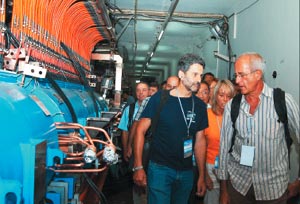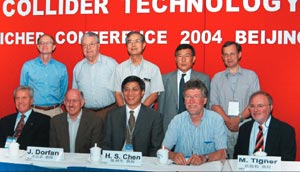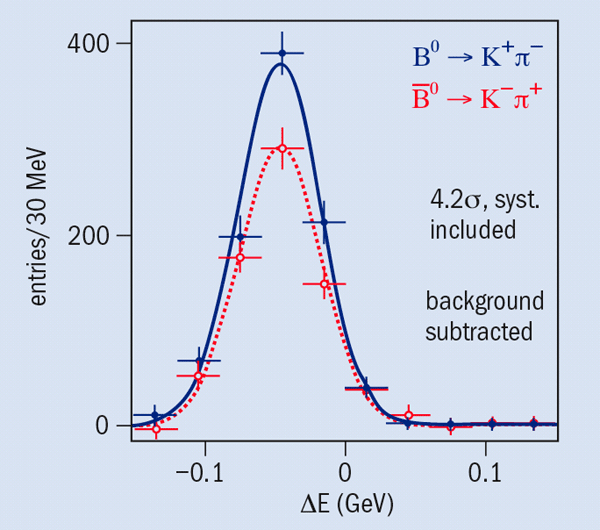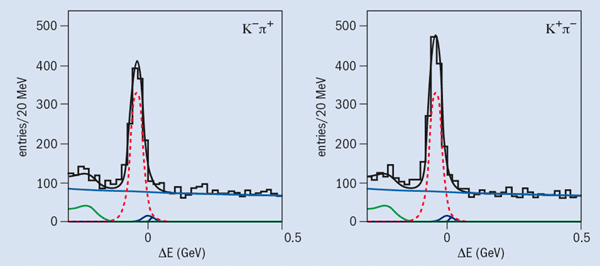The ICHEP ’04 conference provided a major opportunity to review a wide range of recent progress in particle physics.
In 2004, the biennial International Conference on High-Energy Physics (ICHEP) took place for the first time in China, in the capital Beijing, where it was hosted by the Institute of High Energy Physics (IHEP). IHEP was founded in 1950, around the same time that the first conference in this series took place in Rochester, New York. As has become traditional, the conference began with parallel sessions where participants could learn first-hand about the latest results across a broad range of high-energy particle physics. Then, reminiscent of a Chinese banquet of many courses, the plenary sessions presented a succession of offerings reviewing recent progress in the field. A recurring theme was that of precision in areas in which it had once seemed impossible, as in charge-parity (CP) violation and neutrino physics. While studies at the high-energy frontier continue, in general, to bolster the Standard Model, lower energies provided several hot topics, such as the new particle states seen over the past year or so.
Quarks of all flavours
The physics of quarks provided many dishes at this year’s feast of physics, from weak decays through tests of quantum chromodynamics (QCD), the theory of quarks and gluons, to the complex behaviour of quark matter in heavy-ion collisions. In the plenary sessions the menu began with the physics of flavour, where the strange, charm and bottom quarks are all providing a quantitative testing ground for flavour-mixing through the Cabibbo-Kobayashi-Maskawa (CKM) matrix as well as for CP violation. In his talk on the strange quark sector, Vincenzo Patera, from LNF/INFN and Rome, was keen to show that kaons can still make significant contributions. In particular, studies of rare kaon decays, though difficult, are becoming increasingly important: the branching ratios provide the opportunity for direct measurements of the unitarity triangle for CKM flavour-mixing. Also, as recently as 2002, the first row of the CKM matrix (Vud, Vus, Vub) disagreed with unitarity at the level of 2.4σ. Now, new determinations from experiments on the decays K→πeν (Ke3) and K→πμν (Kμ3) at several laboratories – E865 at Brookhaven, KLOE at the Dafne facility, KTeV at Fermilab and NA48 at CERN – provide better agreement with unitarity, and the crisis here seems to be over.

Moving on to the heavier flavour of charm, Ian Shipsey of Purdue spoke of a forthcoming era of precision in absolute charm branching ratios, with data coming from the experiments BESII at IHEP, CLEO-c at Cornell and, later, BESIII. In particular, it will be possible to make precision tests of lattice QCD calculations, which will feed back into determinations of the CKM matrix elements in experiments at the B-factories and elsewhere. Shoji Hashimoto of KEK presented recent results from so-called staggered unquenched lattice QCD simulations, which include the fermion determinant, and yield some interesting results. In particular, in calculations of the CKM matrix elements lattice, QCD can put constraints on the Standard Model and hence provide a guide to new physics.
In the still-heavier bottom-quark sector, the Belle experiment at KEK and BaBar at SLAC are making measurements allowing precision tests of the CKM matrix on many fronts. Now running with continuous injection, the KEKB facility is providing 1 fb-1 a day – or 1 million BBbar-pairs – as reported by Yoshihide Sakai from KEK. PEP-II at SLAC has also been performing well and, in his presentation on results from BaBar, Marcello Giorgi of INFN/Pisa pointed out that, between them, BaBar and Belle have accumulated an integrated luminosity of 0.53 attobarn-1. Perhaps the hottest “dish” served up by the two experiments, however, concerned the first observation of direct CP violation in B-physics. The two experiments measure the difference between the decay B0→K+π– and the decay of the antiparticle, Bbar0→K–π+. Both observe an excess of B-decays, with an average asymmetry of ACP = -0.114 ± 0.020. A similar asymmetry in the decay of the charged B→Kπ0 is not seen, with ACP = -0.04 ± 0.05 ± 0.02, leaving open a door, perhaps, to new physics. The CDF experiment at Fermilab also finds a value for ACP(B0→K+π–) compatible with BaBar and Belle.

Measurements of other decay modes allow different parts of the unitarity triangle to be pinned down. The decay B0→π0π0 has been observed for the first time by BaBar and Belle. This is useful in the determination of the angle α, although the decay to ρρ is better, and the combined result of α=100 + 12 – 10° provides good agreement with a global fit to the CKM matrix. The first measurements of the angle γ are also emerging from other decay modes and are beginning to put constraints on new physics. As Zoltan Ligeti from Lawrence Berkeley Laboratory noted, these first precise tests of the CKM picture are leading to a paradigm change; the aim now is to look for corrections to the picture, rather than alternatives to it. Ahmed Ali of DESY provided a theorist’s overview of heavy quark physics, looking systematically at the parameters of the CKM matrix and the unitarity triangle. Now the precision on Vcb is fast approaching Vus, while more data from the B-factories are needed to pin down Vub. Rare B-decays can also allow the determination of Vts and Vtd.
Top, the heaviest of the quarks, is so much heavier that its study lies in the domain of the highest energies, currently at the Tevatron at Fermilab. Dmitri Denisov of Fermilab showed that Run II at the Tevatron is proceeding well, with a peak luminosity above 1 x 1032 cm-2s-1 and a total integrated luminosity so far of 0.7 fb-1. A new combined result from the CDF and D0 experiments from Run I data is now available, putting the top mass at 178.0 ± 4.3 GeV.

Back in the realm of relatively low-energy quark physics, the story of the pentaquarks presents a picture of “now you see them, now you don’t”, leading many participants at IHEP’04 to question whether pentaquarks exist. The ϑ+(1540) state is seen in as many as 14 different experiments, but it is not seen in nine others. Both experimentalist Shan Jin of IHEP and theorist Frank Close of Oxford emphasized the need to confirm the existence of pentaquarks, as these particles may lead beyond the naive quark model. In his plenary talk, Close took a vote from the audience and found that sceptics outnumbered believers. Other possible multiquark states that have been observed include the X(3872), seen in Belle at KEK and in both CDF and D0 at Fermilab, and the DsJ(2632) seen at Fermilab in the SELEX experiment. Close argued the case that the former is a D-D* molecular state, while the latter may be an artefact – both assertions to be disproved.
Precision and the Standard Model
QCD, the theory of quarks and the strong force, is now becoming more quantitative, with precision measurements at the Tevatron, as presented by Donatella Lucchesi of INFN/Padova, and at HERA, as described by Max Klein of DESY. New results from HERA include the first measurement of the bottom structure function, using b-lifetime tagging and the data from the upgrade, HERA II, where there has been efficient data-taking since October 2003. The HERMES experiment has made the first measurement of the transverse spin structure of the proton, using a target polarized transversely to the direction of the positron beam
The Tevatron, meanwhile, is producing data that allow “precision phenomenology” as highlighted by James Stirling of IPP Durham, with excellent fits to next-to-leading order and next-to-next-to-leading order QCD
Stirling commented that QCD is now established – we are no longer testing it, but are instead using it as part of the toolkit for studying physics at the Large Hadron Collider (LHC). For hard processes, it is a precision tool operating at the per-cent level. He also presented a new scalar graphical approach to QCD calculations by Freddy Cachazo, Peter Svrcek and Edward Witten. This alternative to using Feynman graphs leads to a dramatic simplification and could herald an important breakthrough.

An extreme testing ground for theories of quarks and gluons lies in the physics of heavy-ion collisions where the key question continues to be: has the quark-gluon plasma been seen? In the past couple of years, attention has turned to the experiments at the Relativistic Heavy Ion Collider (RHIC) at Brookhaven, which is producing results in high-energy gold-gold collisions. James Dunlop of Brookhaven National Laboratory described the state of heavy-ion theory as a patchwork; the picture emerging from RHIC is of five observations of bulk, dense, highly interacting matter, which invoke different models. For a compelling argument for quark-gluon plasma, quantitative estimates of theoretical uncertainties are still needed.
The electroweak sector of the Standard Model (SM) has, for some time, been dominated by precision measurements, which are now described at the level of 0.1%. As Frederic Teubert of CERN remarked, this precision is at the level of pure electroweak radiative corrections that are sensitive to heavy particles. This leads to a fitted value for the mass of the Higgs particle, mH = 114 + 69 – 45 GeV, or mH < 260 GeV at a 95% confidence level (CL). The biggest discrepancy in electroweak results is in the interpretation of the ratio of neutral to charged currents as measured in Fermilab’s NuTeV experiment in evaluating the effective weak mixing angle, sin2ϑeff. The biggest challenge, however, is the deviation from the SM of measurements of the anomalous magnetic moment of the muon, which at (aμ – 11659000) x 10-10 = 208 ± 6 now yields a 2.7σ difference from SM theory.
Beyond the Standard Model
Physics beyond the SM provided the dessert course of the plenary session’s “banquet”. Despite, or perhaps because of, their rare interactions with matter through the weak force only, neutrinos are giving a first taste of new physics.

Clark McGrew of Stony Brook and Yifang Wang of IHEP reviewed the current state of accelerator and non-accelerator neutrino experiments respectively, where neutrino oscillations are now clearly established with both man-made and naturally produced neutrinos. The KamLAND reactor-based experiment and the K2K accelerator-based experiment are both revealing a picture consistent with that from Super-Kamiokande (atmospheric neutrinos) and the Sudbury Neutrino Observatory (solar neutrinos). Solar neutrinos yield Δm212 = (8.2 + 0.6 – 0.5) x 10-5 eV2, and a large, but not maximal, mixing angle of tan2 ϑ12 = 0.4 + 0.09 – 0.07; atmospheric neutrinos give Δm223 = (2.4 ± 0.4) x 10-3 eV2 and a maximal mixing angle of sin22ϑ23> 0.92 at a 90% CL. The third angle, ϑ13, is least well known, but from a global fit sin22ϑ13 can be put at < 0.09, 90% CL. Pinning down this angle, which provides a key to CP violation in neutrinos, is one of the big challenges for this field.
New neutrino experiments are coming online. MiniBooNE at Fermilab is going well despite a set-back with a broken neutrino horn (after 108 pulses) and should have sufficient data to release an electron-neutrino appearance result in 2005. The MINOS project, detecting neutrinos from Fermilab in the Soudan Mine 730 km away, should begin its first runs to test beam physics early in 2005. On the theoretical side, Paul Langacker from Pennsylvania noted that the neutrino mixing matrix is very different from the CKM matrix for mixing quark flavours. He pointed to the many possibilities for interpreting this first break with the SM when it comes down to specific models for mixing.
Looking elsewhere in current experiments for new physics beyond the SM, the collaborations working at the recently upgraded Tevatron and HERA machines have reported new limits. As Beate Heinemann from Liverpool summarized, the two machines are now running well and are already providing the world’s best constraints on a great deal of new physics (although nothing novel has yet been found). Uncovering the mechanism of electroweak symmetry-breaking is probably the most important immediate challenge for particle physics. For example, why is the photon massless but the Z not so? Riccardo Barbieri of INFN/Pisa examined the two physical principles behind the calculable models for this symmetry breaking: supersymmetry and the Higgs boson as a pseudo-Goldstone boson. The LHC should make the first real test of these ideas.
For theoretical developments beyond the SM, in particular regarding a quantum theory of gravity, string theory has been offering promise for two decades. Hong Liu of the Massachusetts Institute of Technology reviewed the situation using string theories to address the problems of space-time singularities, in particular the Big Bang and black holes. There is hope for understanding these cosmological singularities and going beyond the SM, with string unification the dream.
Particle physics beyond the Earth was reviewed by Pierre Binetruy of LPTHE Orsay. High-energy gamma rays are providing a wealth of information about the heavens, with the HESS facility in Namibia now bringing in new data. Ultra-high-energy cosmic rays continue to tantalize regarding the existence of the Greisen-Zatsepin-Kuzmin cut-off at 5 x 1019 eV, above which protons from distant sources are “lost” as they interact with the photons of the cosmic microwave background. The AGASA array in Japan has found events at energies above the cut-off, but now the HiRes experiment, based on two nitrogen fluorescence detectors 13 km apart in Utah, has data that confirm the presence of the cut-off.
Beyond the present
The final dishes of the physics feast looked beyond the present to future accelerators and detectors, and were dominated by considerations of a future International Linear Collider (ILC). Two days previously, Jonathan Dorfan, chairman of the International Committee for Future Accelerators, had announced at the conference that the committee had approved the recommendation of the International Technology Recommendation Panel that “cold” technology should be adopted for the future ILC. In discussing R&D for future detectors, Jim Brau of Oregon concentrated on detectors for such a machine. He pointed out that, with the technology selection made, detector efforts could now concentrate on one set of parameters – for example, bunch spacing and the number of bunches per train. The challenges and opportunities differ in many respects from those of detectors for the LHC – events will be simpler, making reconstruction of particle tracks more feasible, while the resolution requirements for the masses of the heavy bosons will set goals for energy measurements.
David Miller of University College, London, presented the case for building a tera-electron-volt ILC as soon as possible (to exploit the findings of the LHC) and argued that a further multi-tera-electron-volt linear collider, and perhaps a larger hadron collider, would also be necessary. Kaoru Yokoya of KEK presented a personal view of the future for accelerators in which he argued that the technology for a Compact Linear Collider (CLIC), although less advanced than the ILC, is much more advanced than for a muon collider. Hence, as a CLIC machine could reach around 3 TeV, the target energy for a muon collider should be greater than 10 TeV.
In a conference demonstrating so much the strength and value of international collaboration, Vera Lüth of SLAC brought the 737 attendees from all over the world up to date on the ongoing problems with US visa approval. In her report on the activities of the International Union of Pure and Applied Physics (IUPAP), she said there is growing recognition that the impact is severe and damage might be irreparable. Despite recent streamlining, the overall process remains “inefficient, unnecessarily lengthy and opaque”. IUPAP has advised it cannot feel confident to sponsor conferences in the US until scientists are guaranteed free access.
The ICHEP conference in China, however, proved very successful. Customs formalities were mercifully brief, and traditional Chinese hospitality was evident in the meals provided and in the tours organized, both for attendees and their guests. These included a trip to IHEP arranged by conference chairman and IHEP director Chen Hesheng, as well as visits to the famous Great Wall and Forbidden City. In his conference summary – the post-banquet drink – John Ellis from CERN was upbeat about the current state of particle physics. QCD works, the CKM matrix is looking better and better, the LHC (with all its promise) is on its way and there are good ideas for the future. Now, as the memories of China begin to fade, there is the next conference in the series to look forward to: ICHEP ’06 in Moscow.
• This report is largely based on the presentations of the plenary speakers. These can be found, together with those from the parallel sessions, at http://ichep04.ihep.ac.cn/.








